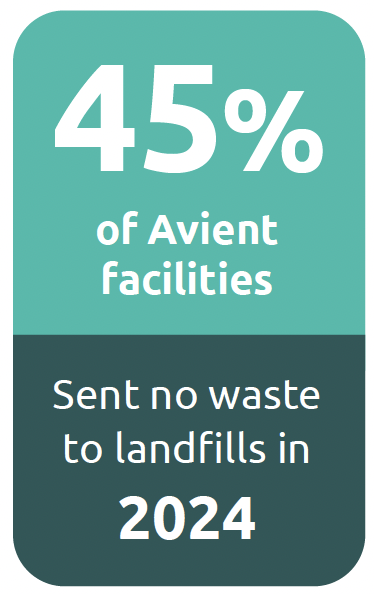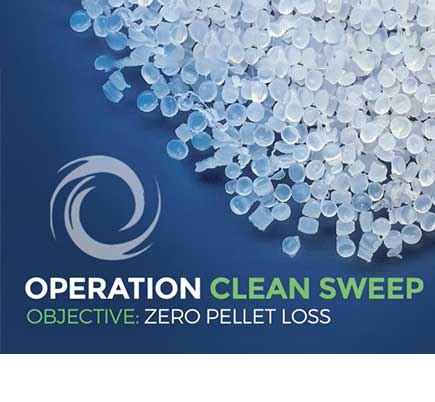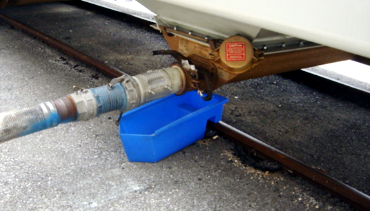
Waste: Preventing, Minimizing, Eliminating
Avient is committed to eliminating or reducing waste generated by our operations and enabling our customers to meet their waste minimization goals.
Our efforts are aimed at reducing the quantity of hazardous and non-hazardous waste generated. Our waste management approach adds value by reducing the risk of environmental harm, as well as costs associated with waste management. These efforts are in line with our commitment to sustainability and strengthen the health of our communities and operations worldwide.
The majority of our waste is non-hazardous process scrap and purge materials. Other wastes may be generated from sources such as periodic construction and demolition projects, packaging from raw materials and products, laboratory waste from quality assurance activities, and routine office-based activities.
Expectations for the management of hazardous and non-hazardous waste are governed by Avient’s internal waste management standards which are applicable to all facilities. These waste standards have established a hierarchy of waste management with the elimination of waste as the highest priority, followed by reuse or recycling, and disposal without any beneficial reuse as the lowest priority. We implement programs to identify reuse opportunities for off-quality products and other waste streams and improve facility resource efficiency to reduce waste generation. Compliance with these expectations is regularly evaluated through our comprehensive EH&S audit program.
Our annual goal of reducing waste to landfill intensity by 3%, as well as annual incentives, are designed to encourage facilities to eliminate waste generation and identify beneficial uses for their remaining waste streams. To monitor progress against these goals, we track waste data from each site on a monthly basis. Beyond quantities of waste generated, this monthly data includes information on positive and negative influences that impact performance.
It is this granular information that Avient utilizes to drive improvement projects. In 2024, we were able to further optimize operations through executing over 70 waste minimization projects around the world. Additionally, 50 of our manufacturing sites globally sent no waste to landfills in 2024. Additionally, Avient introduced Waste Project Awards for projects completed in 2024 in categories such as Most Creative Solution, Best Low- or No-Cost, People’s Choice, and Best Overall.
While our goal focuses on waste impacts from our direct operations, we also seek opportunities along our value chain to work with suppliers to reduce waste associated with shipping materials and with customers by offering products that incorporate recycled content or extend the useful life of a product.
We regularly conduct risk-based audits to inspect external waste disposal and recycling companies to ensure the proper disposal of waste. In this way, we also keep today’s waste from becoming tomorrow’s contamination.
Waste Minimization: Composites
As we continue to work towards our waste minimization goal of 3% reduction in waste to landfill intensity annually, each of our facilities takes an individual approach to reducing waste. Waste minimization plans are impacted by several factors, including raw materials utilized, materials produced, manufacturing process, and location.
Depending on the material, our composite and fiber solutions may run into challenges in finding outlets for waste to divert from landfill. At our facility in Birmingham, Alabama, a team was established to develop a plan for waste minimization. They evaluated existing waste streams, and created a plan to achieve a 25% waste to landfill reduction.
The plan includes a range of options, including repurposing scrap composite rods as fence posts, recycling of scrap glass, and recycling of composite finished goods. In its first year of implementation, the plan is already seeing success. The team continues to identify and qualify new collaborators to recycle and repurpose waste.
This is just one example of the work our teams are doing across Avient’s facilities to deliver on our annual waste goal of 3% reduction of waste to landfill intensity.
Waste Partnerships and Impact

Avient’s global operations participate in Operation Clean Sweep, whose overarching goal is to ensure that every plastic resin handling operation achieves zero loss of pellet, flake, and powder. This greatly helps to protect the environment and save valuable resources. Operation Clean Sweep companies greatly help to prevent plastics from making their way into the ocean, promoting safety, health and cleanliness for marine life. We recognize the importance of responsibly managing plastic pellet loss within our operations.
In addition to ongoing operator training, we conduct regular assessments of our management system procedures to ensure they are effective, and implement improvement measures if needed. On a daily basis, plant personnel monitor structural controls and work practices at our facilities via routine daily rounds.
When a loss of containment is discovered, loose pellets are promptly contained and cleaned up. Pellet recovery equipment, such as skimmers and sieves, are in place to recover pellets captured in our drainage systems.
